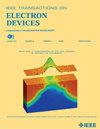Hot Carrier Degradation-Induced Variability in Different Lightly Doped Drain Processes: From Transistors to SRAM Cells
IF 2.9
2区 工程技术
Q2 ENGINEERING, ELECTRICAL & ELECTRONIC
引用次数: 0
Abstract
In this work, the impact of lightly doped drain (LDD) implantation doses on hot carrier degradation (HCD) variability behaviors has been studied for transistors and static random access memory (SRAM) cells. It is found that threshold voltage (不同轻掺杂漏极工艺中由热载流子降解引起的变异性:从晶体管到 SRAM 单元
本文研究了轻掺杂漏极(LDD)植入剂量对晶体管和静态随机存取存储器(SRAM)单元的热载流子降解(HCD)变化行为的影响。研究发现,在 HCD 过程中,n 型 MOSFET(n-MOSFET)和 p 型 MOSFET(p-MOSFET)的阈值电压(${V}_{text {T}}$)变异性增强,而饱和电流(${I}_{text {D}}$)变异性受到抑制。非均匀阱的产生和电流自收敛机制分别用来解释变化的原因。在较高 LDD 剂量下制造的器件变异性较低,这归因于准弹道传输特性的改善。此外,在保持和读取状态下,由于单个晶体管的变异性下降,HCD 对 SRAM 单元静态噪声裕度 (SNM) 变异性的影响也随着 LDD 剂量的增加而受到抑制。因此,LDD 工艺优化有利于晶体管和电路在不增加设计裕量的情况下抵御 HCD 变异。
本文章由计算机程序翻译,如有差异,请以英文原文为准。
求助全文
约1分钟内获得全文
求助全文
来源期刊

IEEE Transactions on Electron Devices
工程技术-工程:电子与电气
CiteScore
5.80
自引率
16.10%
发文量
937
审稿时长
3.8 months
期刊介绍:
IEEE Transactions on Electron Devices publishes original and significant contributions relating to the theory, modeling, design, performance and reliability of electron and ion integrated circuit devices and interconnects, involving insulators, metals, organic materials, micro-plasmas, semiconductors, quantum-effect structures, vacuum devices, and emerging materials with applications in bioelectronics, biomedical electronics, computation, communications, displays, microelectromechanics, imaging, micro-actuators, nanoelectronics, optoelectronics, photovoltaics, power ICs and micro-sensors. Tutorial and review papers on these subjects are also published and occasional special issues appear to present a collection of papers which treat particular areas in more depth and breadth.
 求助内容:
求助内容: 应助结果提醒方式:
应助结果提醒方式:


